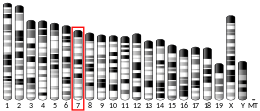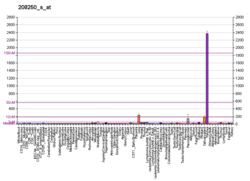DMBT1
Deleted in malignant brain tumors 1 protein is a protein that in humans is encoded by the DMBT1 gene.[5][6]
Function
Loss of sequences from human chromosome 10q has been associated with the progression of human cancers. The gene DMBT1 was originally isolated based on its deletion in a medulloblastoma cell line. DMBT1 is expressed with transcripts of 6.0, 7.5, and 8.0 kb in fetal lung and with one transcript of 8.0 kb in adult lung, although the 7.5 kb transcript has not been characterized. The DMBT1 protein is a glycoprotein containing multiple scavenger receptor cysteine-rich (SRCR) domains separated by SRCR-interspersed domains (SID). Transcript variant 2 (8.0 kb) has been shown to bind surfactant protein D independently of carbohydrate recognition. This indicates that DMBT1 may not be a classical tumor suppressor gene, but rather play a role in the interaction of tumor cells and the immune system.[7]
Pattern recognition and potential use of DMBT1 in nanomedicine
At epithelial barriers molecular pattern recognition mechanisms act as minesweepers against harmful environmental factors and thereby play a crucial role in the defense against invading bacterial and viral pathogens. However, it became evident that some of the proteins participating in these host defense processes may simultaneously function as regulators of tissue regeneration when in the extracellular matrix, thus coupling defense functions with regulation of stem cells. Although molecular pattern recognition has complex physiological roles and we just begin to understand its various functions, the simplicity of the underlying principles for recognition of specific classes of molecules may generate novel starting points for nanomedical approaches in drug delivery across epithelial barriers. The protein DMBT1, showed pattern recognition activity for poly-sulfated and poly-phosphorylated ligands, including nucleic acids, and the ability to aggregate ligands. This raises the interesting question in how far these properties can be utilized to assemble nucleic acidpeptide nano-complexes and whether this can be exploited to modulate the pharmacological properties of nucleic acids and/or for nucleic acid delivery to target cells [8] Recently, DMBT1-derived peptides have been successfully harnessed for siRNA intracellular delivery. [9]
Interactions
DMBT1 has been shown to interact with Surfactant protein D.[10][11] DMBT1-derived peptides also interacts with nucleic acids. [9]
References
- GRCh38: Ensembl release 89: ENSG00000187908 - Ensembl, May 2017
- GRCm38: Ensembl release 89: ENSMUSG00000047517 - Ensembl, May 2017
- "Human PubMed Reference:". National Center for Biotechnology Information, U.S. National Library of Medicine.
- "Mouse PubMed Reference:". National Center for Biotechnology Information, U.S. National Library of Medicine.
- Mollenhauer J, Wiemann S, Scheurlen W, Korn B, Hayashi Y, Wilgenbus KK, von Deimling A, Poustka A (Oct 1997). "DMBT1, a new member of the SRCR superfamily, on chromosome 10q25.3-26.1 is deleted in malignant brain tumours". Nat. Genet. 17 (1): 32–9. doi:10.1038/ng0997-32. PMID 9288095.
- Rosenstiel P, Sina C, End C, Renner M, Lyer S, Till A, Hellmig S, Nikolaus S, Fölsch UR, Helmke B, Autschbach F, Schirmacher P, Kioschis P, Hafner M, Poustka A, Mollenhauer J, Schreiber S (Jun 2007). "Regulation of DMBT1 via NOD2 and TLR4 in intestinal epithelial cells modulates bacterial recognition and invasion". J. Immunol. 178 (12): 8203–11. doi:10.4049/jimmunol.178.12.8203. PMID 17548659.
- "Entrez Gene: DMBT1 deleted in malignant brain tumors 1".
- Casella, Cinzia; Tuttolomondo, Martina; Høilund-Carlsen, Poul Flemming; Mollenhauer, Jan (2014-01-01). "Natural pattern recognition mechanisms at epithelial barriers and potential use in nanomedicine". European Journal of Nanomedicine. 6 (3). doi:10.1515/ejnm-2014-0020. ISSN 1662-596X.
- Tuttolomondo, Martina; Casella, Cinzia; Hansen, Pernille Lund; Polo, Ester; Herda, Luciana M.; Dawson, Kenneth A.; Ditzel, Henrik J.; Mollenhauer, Jan (2017). "Human DMBT1-Derived Cell-Penetrating Peptides for Intracellular siRNA Delivery". Molecular Therapy - Nucleic Acids. 8: 264–276. doi:10.1016/j.omtn.2017.06.020. ISSN 2162-2531. PMC 5514624. PMID 28918028.
- Tino MJ, Wright JR (1999). "Glycoprotein-340 binds surfactant protein-A (SP-A) and stimulates alveolar macrophage migration in an SP-A-independent manner". Am. J. Respir. Cell Mol. Biol. 20 (4): 759–68. doi:10.1165/ajrcmb.20.4.3439. PMID 10101009.
- Holmskov U, Lawson P, Teisner B, Tornoe I, Willis AC, Morgan C, Koch C, Reid KB (1997). "Isolation and characterization of a new member of the scavenger receptor superfamily, glycoprotein-340 (gp-340), as a lung surfactant protein-D binding molecule". J. Biol. Chem. 272 (21): 13743–9. doi:10.1074/jbc.272.21.13743. PMID 9153228.
Further reading
- Kang W, Reid KB (2003). "DMBT1, a regulator of mucosal homeostasis through the linking of mucosal defense and regeneration?". FEBS Lett. 540 (1–3): 21–5. doi:10.1016/S0014-5793(03)00217-5. PMID 12681477.
- Robbe C, Paraskeva C, Mollenhauer J, Michalski JC, Sergi C, Corfield A (2005). "DMBT1 expression and glycosylation during the adenoma-carcinoma sequence in colorectal cancer". Biochem. Soc. Trans. 33 (Pt 4): 730–2. doi:10.1042/BST0330730. PMID 16042587.
- Rasheed BK, McLendon RE, Friedman HS, Friedman AH, Fuchs HE, Bigner DD, Bigner SH (1995). "Chromosome 10 deletion mapping in human gliomas: a common deletion region in 10q25". Oncogene. 10 (11): 2243–6. PMID 7784070.
- Holmskov U, Lawson P, Teisner B, Tornoe I, Willis AC, Morgan C, Koch C, Reid KB (1997). "Isolation and characterization of a new member of the scavenger receptor superfamily, glycoprotein-340 (gp-340), as a lung surfactant protein-D binding molecule". J. Biol. Chem. 272 (21): 13743–9. doi:10.1074/jbc.272.21.13743. PMID 9153228.
- Mori M, Shiraishi T, Tanaka S, Yamagata M, Mafune K, Tanaka Y, Ueo H, Barnard GF, Sugimachi K (1999). "Lack of DMBT1 expression in oesophageal, gastric and colon cancers". Br. J. Cancer. 79 (2): 211–3. doi:10.1038/sj.bjc.6690035. PMC 2362205. PMID 9888459.
- Tino MJ, Wright JR (1999). "Glycoprotein-340 binds surfactant protein-A (SP-A) and stimulates alveolar macrophage migration in an SP-A-independent manner". Am. J. Respir. Cell Mol. Biol. 20 (4): 759–68. doi:10.1165/ajrcmb.20.4.3439. PMID 10101009.
- Holmskov U, Mollenhauer J, Madsen J, Vitved L, Gronlund J, Tornoe I, Kliem A, Reid KB, Poustka A, Skjodt K (1999). "Cloning of gp-340, a putative opsonin receptor for lung surfactant protein D". Proc. Natl. Acad. Sci. U.S.A. 96 (19): 10794–9. Bibcode:1999PNAS...9610794H. doi:10.1073/pnas.96.19.10794. PMC 17962. PMID 10485905.
- Takeshita H, Sato M, Shiwaku HO, Semba S, Sakurada A, Hoshi M, Hayashi Y, Tagawa Y, Ayabe H, Horii A (1999). "Expression of the DMBT1 gene is frequently suppressed in human lung cancer". Jpn. J. Cancer Res. 90 (9): 903–8. doi:10.1111/j.1349-7006.1999.tb00833.x. PMC 5926167. PMID 10551316.
- Mollenhauer J, Holmskov U, Wiemann S, Krebs I, Herbertz S, Madsen J, Kioschis P, Coy JF, Poustka A (1999). "The genomic structure of the DMBT1 gene: evidence for a region with susceptibility to genomic instability". Oncogene. 18 (46): 6233–40. doi:10.1038/sj.onc.1203071. PMID 10597221.
- Prakobphol A, Xu F, Hoang VM, Larsson T, Bergstrom J, Johansson I, Frängsmyr L, Holmskov U, Leffler H, Nilsson C, Borén T, Wright JR, Strömberg N, Fisher SJ (2000). "Salivary agglutinin, which binds Streptococcus mutans and Helicobacter pylori, is the lung scavenger receptor cysteine-rich protein gp-340". J. Biol. Chem. 275 (51): 39860–6. doi:10.1074/jbc.M006928200. PMID 11007786.
- Ma JF, Takito J, Vijayakumar S, Peehl DM, Olsson CA, Al-Awqati Q (2001). "Prostatic expression of hensin, a protein implicated in epithelial terminal differentiation". Prostate. 49 (1): 9–18. doi:10.1002/pros.1113. PMID 11550206.
- Ligtenberg TJ, Bikker FJ, Groenink J, Tornoe I, Leth-Larsen R, Veerman EC, Nieuw Amerongen AV, Holmskov U (2001). "Human salivary agglutinin binds to lung surfactant protein-D and is identical with scavenger receptor protein gp-340". Biochem. J. 359 (Pt 1): 243–8. doi:10.1042/0264-6021:3590243. PMC 1222141. PMID 11563989.
- Mollenhauer J, Herbertz S, Helmke B, Kollender G, Krebs I, Madsen J, Holmskov U, Sorger K, Schmitt L, Wiemann S, Otto HF, Gröne HJ, Poustka A (2001). "Deleted in Malignant Brain Tumors 1 is a versatile mucin-like molecule likely to play a differential role in digestive tract cancer". Cancer Res. 61 (24): 8880–6. PMID 11751412.
- Bikker FJ, Ligtenberg AJ, van der Wal JE, van den Keijbus PA, Holmskov U, Veerman EC, Nieuw Amerongen AV (2002). "Immunohistochemical detection of salivary agglutinin/gp-340 in human parotid, submandibular, and labial salivary glands". J. Dent. Res. 81 (2): 134–9. doi:10.1177/154405910208100210. PMID 11829014.
- Sasaki H, Betensky RA, Cairncross JG, Louis DN (2002). "DMBT1 polymorphisms: relationship to malignant glioma tumorigenesis". Cancer Res. 62 (6): 1790–6. PMID 11912156.CS1 maint: uses authors parameter (link)
- Schulz BL, Oxley D, Packer NH, Karlsson NG (2002). "Identification of two highly sialylated human tear-fluid DMBT1 isoforms: the major high-molecular-mass glycoproteins in human tears". Biochem. J. 366 (Pt 2): 511–20. doi:10.1042/BJ20011876. PMC 1222789. PMID 12015815.
- Bikker FJ, Ligtenberg AJ, Nazmi K, Veerman EC, van't Hof W, Bolscher JG, Poustka A, Nieuw Amerongen AV, Mollenhauer J (2002). "Identification of the bacteria-binding peptide domain on salivary agglutinin (gp-340/DMBT1), a member of the scavenger receptor cysteine-rich superfamily". J. Biol. Chem. 277 (35): 32109–15. doi:10.1074/jbc.M203788200. PMID 12050164.
- Fan X, Muñoz J, Sanko SG, Castresana JS (2002). "PTEN, DMBT1, and p16 alterations in diffusely infiltrating astrocytomas". Int. J. Oncol. 21 (3): 667–74. doi:10.3892/ijo.21.3.667. PMID 12168116.
- Mueller W, Mollenhauer J, Stockhammer F, Poustka A, von Deimling A (2002). "Rare mutations of the DMBT1 gene in human astrocytic gliomas". Oncogene. 21 (38): 5956–9. doi:10.1038/sj.onc.1205733. PMID 12185598.




